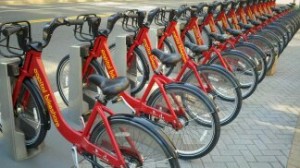Bike share gives you another way to travel short distances, such as from a Metro station to a nearby restaurant. 110 of the solar-powered bike share stations have sprung up in the busier areas of Washington and Arlington.
My ride
Rolling away from the station outside the entrance to the Crystal City Metro, I immediately felt comfortable on my CaBi bike. The weight of the sturdy frame and the three gears kept my progress slow and under control as we negotiated stop-and-go car traffic.
Since I was used to seeing Crystal City from a car window, I thought it wasn’t much more than a drab concrete jungle. But gliding slowly along, I got a closeup view of how much had changed since I moved from the area thirty years ago. Now, beautiful potted plants dot street corners. Graceful shade trees sway in the breeze. Sidewalk cafes beckon.
And bike share stations are located every couple of blocks. That close proximity is what makes the system a viable form of transportation. Our tourguide tells us that lots of people now grab a bike instead of a taxi or bus. They predict that as Metrorail gets more crowded, bike share will become a desired alternative for more people and actually free up spaces on trains.
I liked my bike in D.C. better than the one I rode last summer in Milan. For one thing, a bungy cord secures your stuff in the cargo rack. We were bummed in Italy when our new DSLR camera slid out of the open metal basket and crashed on the sidewalk. Capital Bikeshare maintenance folks report their bikes are much more reliable then the finicky fleet in Paris.
I wore business clothes for the ride and soon realized one’s outfit should rarely be an impediment. Truth be told, if you’re wearing high heels and have to go any distance at all, it’s a lot more comfortable to ride a bike than it is to walk.
CaBi facts
Capital Bikeshare is remarkably safe. More than 700,000 rides have been taken on the system since CaBi opened last fall, but there have been very few accidents. In fact, medical assistance has only been necessary in only about a dozen instances. CaBi adds an additional measure of safety by teaming up with the Washington Area Bicyclist Association to offer free classes in negotiating city traffic.
Bike share is a great deal. You’ll need to pay to get into the system. A year-long membership costs $75. It’s $30 for a month and $5 for a day. But having done that, any time you use a bike, the first half hour is free. If you time it right, you could take as many short hops as you want and never pay another dime.
As for tech support, clear instructions and a bike locator map are on the CaBi website. A free smart phone app, www.SpotCycle.net, is an easy way to check as you’re riding whether there is an open spot to return your bike at your destination.
Scores of new bike share stations are planned for new places, including Montgomery County and Alexandria. But there’s no need to wait for a full build-out. If, for instance, you want to go from Capitol Hill to a meeting on K Street, it may be faster and cheaper to check out a CaBi than to wait for a cab and risk getting caught in traffic.






